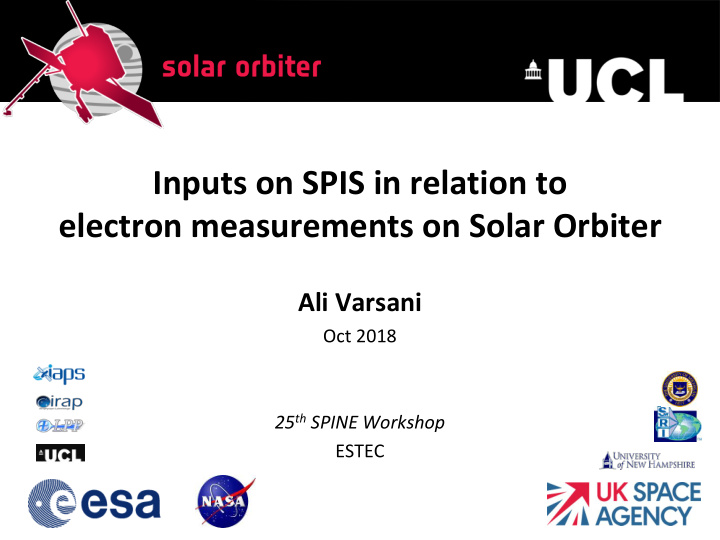



Inputs on SPIS in relation to electron measurements on Solar Orbiter Ali Varsani Oct 2018 25 th SPINE Workshop ESTEC
Baseline Mission Profile • Launch: Feb 2020, Vehicle : NASA‘s Atlas V • Total mission duration, incl. extended phase: >10 yrs • Cruise phase (~3.5 years): • Chemical Propulsion; • Multiple gravity assist manoeuvres (Venus, Earth); Image courtesy: EAS, NASA • Science phase: Info: Airbus, ESA SWA team • Three-axis stabilised, Sun pointing; • Raising of orbit inclination angle; • Overall mass: ~1750 kg; • Maximum power demand: ~1100W
Instruments and Measurements Info: Airbus, ESA, NASA Investigation Measurements Solar Wind Analyzer (SWA) Solar wind ion and electron bulk properties, ion composition (1eV- 5 keV electrons; 0.2 - 100 keV/q ions) In Situ Group Energetic Particle Detector (EPD) Composition, timing, and distribution functions of suprathermal and energetic particles (8 keV/n – 200 MeV/n ions; 20-700 keV electrons) Magnetometer (MAG) DC vector magnetic fields (0 – 64 Hz) Radio & Plasma Waves (RPW) AC electric and magnetic fields (~DC – 20 MHz) Polarimetric and Helioseismic Imager (PHI) Vector magnetic field and line-of-sight velocity in the photosphere Remote Sensing Group EUV Imager (EUI) Full-disk EUV and high-resolution EUV and Lyman- α imaging of the solar atmosphere Spectral Imaging of the Coronal Environment EUV spectroscopy of the solar disk and corona (SPICE) X-ray Spectrometer Telescope (STIX) Solar thermal and non-thermal X-ray emission (4 – 150 keV) Coronagraph (METIS/COR) Visible, UV and EUV imaging of the solar corona Heliospheric Imager (SolOHI) White-light imaging of the extended corona
SWA Hardware Elements DPU (Internal) HIS EAS PAS (obscured) Image courtesy: EAS, NASA Info: Airbus, ESA SWA team
SWA Hardware Elements Image courtesy: EAS, NASA Info: Airbus, ESA, SWA team Subsystem Electron Heavy Ion Proton and Data Analyser sensor (HIS) Alpha sensor Processing system (EAS) (PAS) Unit (DPU) DPU HIS (Internal) EAS PAS (obscured) Species Electrons Heavy Ions Protons and Alpha - Particles High temporal The velocity Measurement Major charge states Provide SWA suite resolution distribution of protons of C, O and Fe; 3-D control, commanding determination of the and alpha particles velocity distributions and data handling core, halo and strahl of prominent heavy (0.2 < E < 20 keV/q) at functions. electron velocity high time resolution solar wind ions, distributions (1 eV < E equivalent to the suprathermal ions, < 5 keV) and their ambient proton and pick-up ions of moments cyclotron period. various origins, such as weakly-ionized species (He + , O + )
The SWA Electron Analyser System (EAS) • 3D Electrons measurement , 0 - 5 keV, using electrostatic analyser • Combined FoV is full sky (although there is blockage by the spacecraft). Image courtesy: EAS
The SWA Electron Analyser System • 3D Electrons measurement , 0 - 5 keV, using electrostatic analyser • Combined FoV is full sky (although there is blockage by the spacecraft) • Additional blockage due to the new baffle being added Image courtesy: EAS
Challenges • Spacecraft charging can potentially affect the science done by the particle instruments including SWA sensor. • EAS original requirements : – no part of S/C should be charged +1 V different to the other part – no strong charging overall (> ~10V) – no strong B field, which affects the electron distributions Spacecraft potential simulations by Stanislas Guillemant and Vincent Genot, IRAP
Example of an excellent study done by Déprez et al.: Courtesy of Solar Orbiter project / ESTEC Presented by Déprez et al., July 2018
Courtesy of Solar Orbiter project / ESTEC Presented by Déprez et al., July 2018
Courtesy of Solar Orbiter project / ESTEC Presented by Déprez et al., July 2018
Open questions: Propellants differ in types, and as a result the ice composition varies • Could SPIS include the composition of droplet and or their conductivity profile based on the temperature ? Droplets can contaminate the S/C via scattered spots of ice, or as a solid layer. • Could SPIS include calculations based on the effect of each? • The design of Solar Orbiter (including adding baffle) are all to make sure the measurements are least affected. However there will be S/C charging, and: After the launch of Solar Orbiter, SPIS will be crucial for understanding how the charging affects our electron measurement.
End-to-end simulation: SPIS is a powerful tool, and indeed very valuable for the science to be done by Solar Orbiter. Analysis of various surfaces had been done. For the best science operations we would prefer to have the S/C model with all the surfaces included. Ideally, we would like to be able to do a simulation where: o The user could enter environmental conditions, e.g. distance to the sun o Add a source of electrons in infinity o Run SPIS and see how S/C charging affects the distribution of the electrons (for instance the trajectory , and velocity) This way we could take the measured distribution, and extract the original distribution of the plasma .
Recommend
More recommend